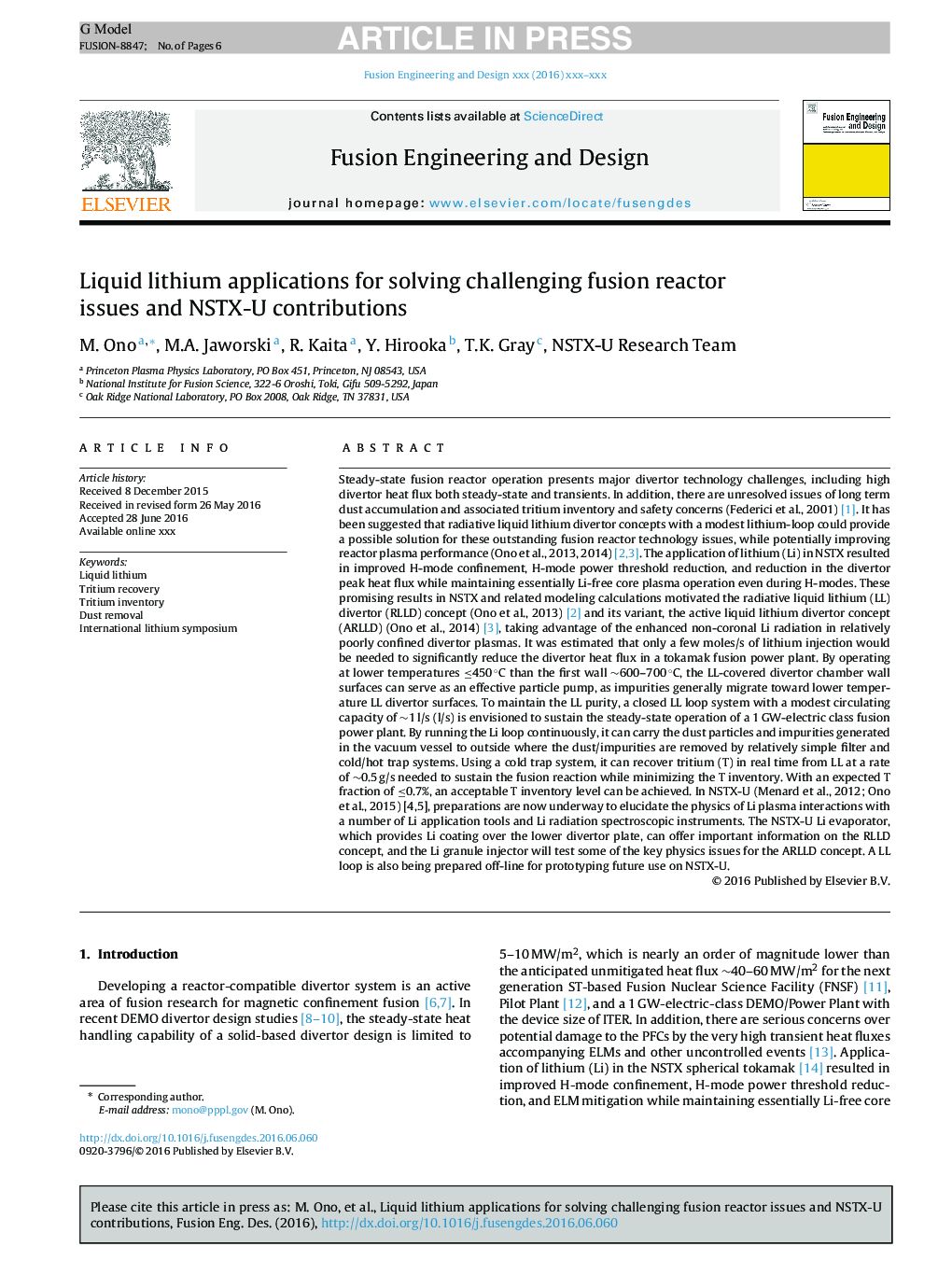| کد مقاله | کد نشریه | سال انتشار | مقاله انگلیسی | نسخه تمام متن |
|---|---|---|---|---|
| 4921269 | 1429336 | 2017 | 6 صفحه PDF | دانلود رایگان |
عنوان انگلیسی مقاله ISI
Liquid lithium applications for solving challenging fusion reactor issues and NSTX-U contributions
دانلود مقاله + سفارش ترجمه
دانلود مقاله ISI انگلیسی
رایگان برای ایرانیان
کلمات کلیدی
موضوعات مرتبط
مهندسی و علوم پایه
مهندسی انرژی
مهندسی انرژی و فناوری های برق
پیش نمایش صفحه اول مقاله

چکیده انگلیسی
Steady-state fusion reactor operation presents major divertor technology challenges, including high divertor heat flux both steady-state and transients. In addition, there are unresolved issues of long term dust accumulation and associated tritium inventory and safety concerns (Federici et al., 2001) [1]. It has been suggested that radiative liquid lithium divertor concepts with a modest lithium-loop could provide a possible solution for these outstanding fusion reactor technology issues, while potentially improving reactor plasma performance (Ono et al., 2013, 2014) [2,3]. The application of lithium (Li) in NSTX resulted in improved H-mode confinement, H-mode power threshold reduction, and reduction in the divertor peak heat flux while maintaining essentially Li-free core plasma operation even during H-modes. These promising results in NSTX and related modeling calculations motivated the radiative liquid lithium (LL) divertor (RLLD) concept (Ono et al., 2013) [2] and its variant, the active liquid lithium divertor concept (ARLLD) (Ono et al., 2014) [3], taking advantage of the enhanced non-coronal Li radiation in relatively poorly confined divertor plasmas. It was estimated that only a few moles/s of lithium injection would be needed to significantly reduce the divertor heat flux in a tokamak fusion power plant. By operating at lower temperatures â¤450 °C than the first wall â¼600-700 °C, the LL-covered divertor chamber wall surfaces can serve as an effective particle pump, as impurities generally migrate toward lower temperature LL divertor surfaces. To maintain the LL purity, a closed LL loop system with a modest circulating capacity of â¼1 l/s (l/s) is envisioned to sustain the steady-state operation of a 1 GW-electric class fusion power plant. By running the Li loop continuously, it can carry the dust particles and impurities generated in the vacuum vessel to outside where the dust/impurities are removed by relatively simple filter and cold/hot trap systems. Using a cold trap system, it can recover tritium (T) in real time from LL at a rate of â¼0.5 g/s needed to sustain the fusion reaction while minimizing the T inventory. With an expected T fraction of â¤0.7%, an acceptable T inventory level can be achieved. In NSTX-U (Menard et al., 2012; Ono et al., 2015) [4,5], preparations are now underway to elucidate the physics of Li plasma interactions with a number of Li application tools and Li radiation spectroscopic instruments. The NSTX-U Li evaporator, which provides Li coating over the lower divertor plate, can offer important information on the RLLD concept, and the Li granule injector will test some of the key physics issues for the ARLLD concept. A LL loop is also being prepared off-line for prototyping future use on NSTX-U.
ناشر
Database: Elsevier - ScienceDirect (ساینس دایرکت)
Journal: Fusion Engineering and Design - Volume 117, April 2017, Pages 124-129
Journal: Fusion Engineering and Design - Volume 117, April 2017, Pages 124-129
نویسندگان
M. Ono, M.A. Jaworski, R. Kaita, Y. Hirooka, T.K. Gray, NSTX-U Research Team NSTX-U Research Team,